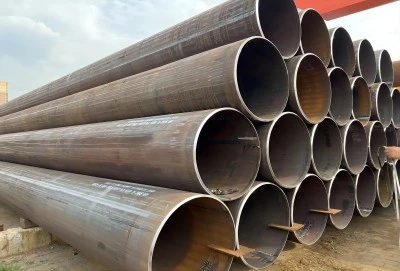Definition And Specification
Large diameter welded pipes represent a crucial component in modern industrial infrastructure. These pipes are characterized by their substantial size, with diameters typically starting from 300 mm (12 inches) and extending up to an impressive 4000 mm (13 feet 4 inches). This size classification has become an industry standard, distinguishing these pipes from their smaller counterparts used in more conventional applications.
The specification of large diameter welded pipes encompasses various dimensional parameters beyond just diameter. Wall thickness is a critical factor, usually ranging from 6mm to 100mm depending on the application requirements. The length of these pipes can also vary significantly, with standard lengths typically between 6 to 18 meters, though custom lengths can be manufactured based on specific project needs. The sizing specifications are typically governed by international standards such as API 5L, ASTM A53, and EN 10219.
|
|
|
Manufacturing Process
The manufacturing of large diameter welded pipes involves sophisticated processes that ensure structural integrity and reliability. The two primary manufacturing methods each have their distinct advantages and applications. The first method utilizes the Longitudinal Submerged Arc Welding (LSAW) process, where steel coils are carefully unrolled and formed into a cylindrical shape. The edges are then precisely welded along the entire length of the pipe. This method is particularly favored for high-pressure applications due to the superior weld quality it provides.
The second manufacturing approach employs Double-sided Submerged Arc Welding (DSAW), starting with steel plates rather than coils. The plates are meticulously rolled into a tubular form and welded on both sides, creating a robust seam that runs the length of the pipe. This method offers exceptional control over wall thickness and is particularly suitable for pipes requiring superior mechanical properties. The DSAW process typically involves multiple stages of quality control, including radiographic testing of welds and hydrostatic pressure testing. Both manufacturing processes incorporate advanced automation and precise control systems to ensure consistency in pipe geometry and weld quality. The welding parameters, including current, voltage, and travel speed, are carefully monitored and adjusted throughout the process. Post-welding heat treatment may also be applied to relieve residual stresses and enhance the pipe's mechanical properties.
Application Areas
Large diameter welded pipes find extensive applications across various industries, serving as critical components in major infrastructure projects. In construction, they are extensively used for bored pile casings, providing essential support and protection in deep foundation works. Their application in jacking and pressure cast-in-place piles demonstrates their versatility in foundation engineering, where they must withstand significant ground pressures and installation stresses.
The utility sector heavily relies on these pipes for transmission lines, where their large diameter facilitates efficient fluid transport over long distances. In the energy sector, they serve as crucial components in oil and gas pipelines, where their robust construction and reliable welding ensure the safe transportation of resources. Sign poles and transmission towers represent another significant application area, where the pipes' structural integrity is essential for supporting substantial loads and resisting environmental forces. Because of their remarkable strength, resilience to corrosion, and durability—all of which are critical in these harsh environments—large diameter welded pipes are used extensively in both marine and offshore applications. Large diameter welded pipes serve as the foundation of the infrastructure when building caissons, offshore oil rigs, and other marine structures. The safety and longevity of the structures depend on these pipes meeting strict quality standards because they are subjected to harsh conditions like high pressures, corrosion from saltwater, and continuous mechanical stresses. Even in the most difficult circumstances, marine and offshore facilities are guaranteed to remain secure and operational due to the high structural integrity of welded pipes.
Material Properties
The material properties of large diameter welded pipes are fundamental to their performance and versatility. Their symmetrical cross-section provides uniform bending strength in all directions, a crucial characteristic for structural applications. This inherent property makes them particularly effective in resisting buckling loads, which is essential in deep foundation works and vertical structural elements.
The steel grades used in manufacturing these pipes typically range from basic carbon steel to high-strength low-alloy (HSLA) steels, depending on the application requirements. Common grades include API 5L X42 through X70, offering varying combinations of strength and ductility. The material selection considers factors such as operating pressure, temperature requirements, and environmental conditions. To make sure they match or surpass the strength and durability of the base material, welded joints in large diameter pipes are subjected to stringent testing. To find any flaws like cracks, voids, or incomplete fusion that could jeopardize the integrity of the weld, this testing usually consists of non-destructive techniques like visual inspection, x-ray inspection, and ultrasonic testing. These tests are essential in high-stakes situations like offshore, industrial, and marine environments where the welds' dependability is critical. To create precise, high-quality welds with little distortion, modern welding techniques like Gas Tungsten Arc Welding (GTAW or TIG welding) are used.
Wholesale Large Diameter Welded Pipe
LONGMA GROUP specializes in manufacturing large diameter welded pipes using various welding technologies including ERW (Electric Resistance Welding), LSAW (Longitudinal Submerged Arc Welding), DSAW (Double-sided Submerged Arc Welding), and SSAW (Spiral Submerged Arc Welding). Each welding method is selected based on specific application requirements and performance criteria.
The company maintains strict quality control procedures throughout the manufacturing process, ensuring compliance with international standards and customer specifications. Their production capabilities encompass a wide range of pipe sizes and steel grades, making them a versatile supplier for various industrial applications. Potential customers interested in sourcing large diameter welded pipes can reach out to LONGMA GROUP at info@longma-group.com for detailed product information and technical support.














